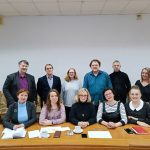Center for International Cooperation in Education Development (CICED) presented a series of reports on the use of monitoring research materials for the development of education in the framework of READ Program conference held in Moscow. Petr Nezhnov, head of the SAM (Test ’Achievement Monitoring) development team, presented the history, purpose, features and development prospects of this research tool.
According to him, a PISA study conducted in Russia in the early 2000s led to the setting of new goals in educational policy, however, the data retrieved did not reflect subject competence level of teachers and students and could not be used for decision making on education reforming. The three-level SAM methodology, based on the theory of L. Vygotsky, in turn, has clear criteria for assessing such competencies, which in turn, allows planning educational interventions and giving recommendations for improving the educational process.
SAM test, unlike PISA, allows the teacher to see their subject from the inside in terms of conceptual content, can be used to get feedback from students and even prepare for examinations. Speaking about the prospects, the speaker noted that a set of tools based on SAM methodology for elementary school has undergone extensive long-term testing and is successfully developing. At the moment, the developers are planning to make a retrospective module for students and teachers, which will increase the level of subject competence of students at level 1 who have graduated from primary school.
Vladimir Lvovsky, the author of the training program “SAM in teacher’s practice” also agreed on necessity of expanding the range of SAM tools. He noted that the SAM methodology can be successfully applied both for evaluating high school pupils, students, and teachers, the target audience of the mentioned program. It is based on the construction of test items in accordance with the structure and criteria of SAM. Working on the compilation, refinement and testing of items teachers have an opportunity to improve their competence and gain comprehensive understanding of the subject. Along with this, teachers learn to include level 2 and 3 tasks in their curricula and use them as a diagnostic tool for assessing the level of students’ subject competence. In conclusion, V. Lvovsky noted that the objective of the training program is also to motivate teachers to address “understanding, not skills,” in other words to foster subject competence as a substitute to train pupils to solve typical problems.
Alexey Vorontsov, author of the “Diagnostics of Pedagogical Practices” educational module, also set himself a task to identify which of the pedagogical practices used by school teachers contribute to fostering of comprehensive understanding of the subject. This work resulted in the identification of key pedagogical actions and compilation of a matrix that includes actions of both a teacher and a pupils and the rationale of their necessity for effective learning. At the next step, the levels of the teacher’s use of key pedagogical actions were categorized in accordance with the SAM taxonomy and finally a test was compiled consisting of blocks of situational methodological pedagogical tasks. Thus, when diagnosing teachers in parallel with the SAM test, comparison of the results of pupils and their teachers becomes possible. In addition, the study allows determining what pedagogical actions are actively used by a teacher and which of them are minor, opening the potential to build individual tracks for teachers’ advanced training.
All session participants noted the significant contribution of READ components to the development of SAM family tools and expressed interest in continuing cooperation with the Program.








